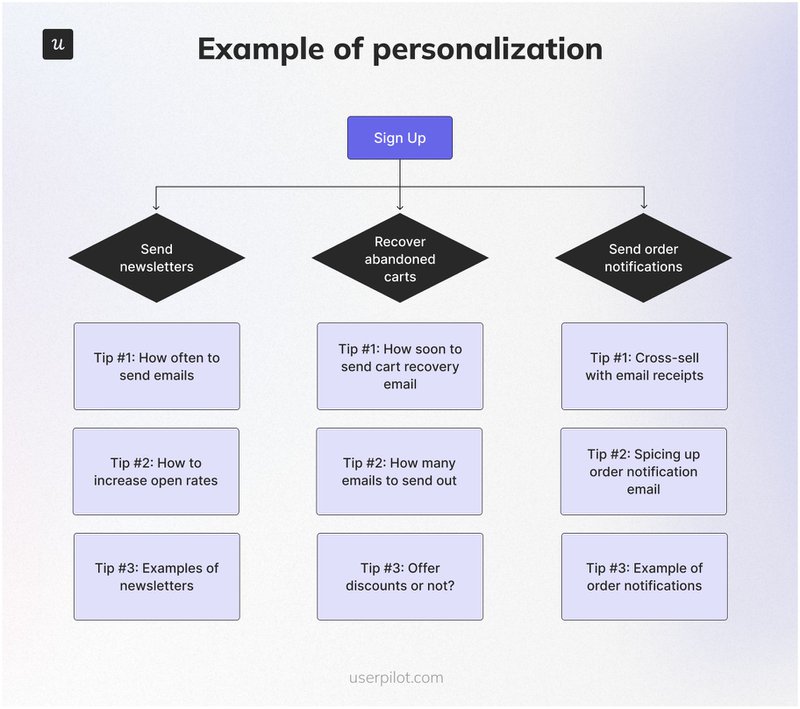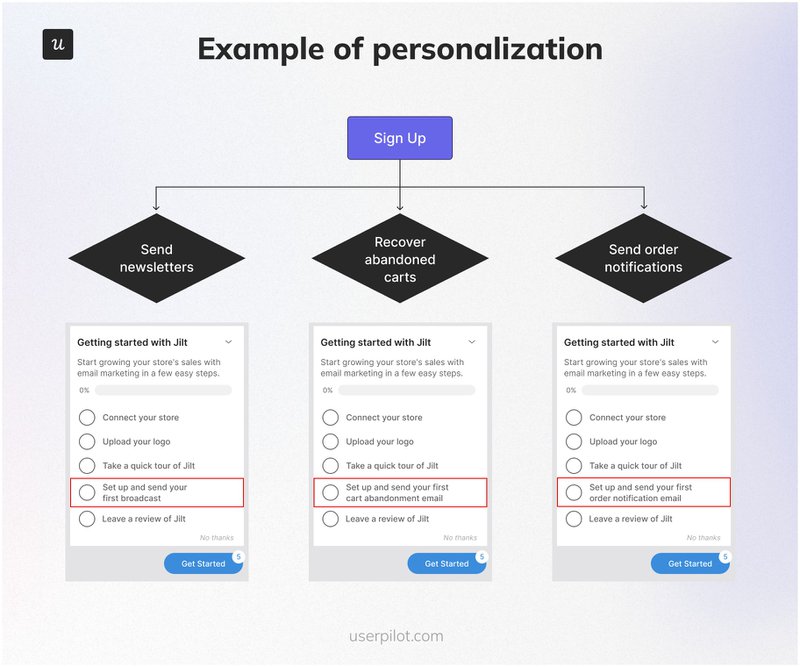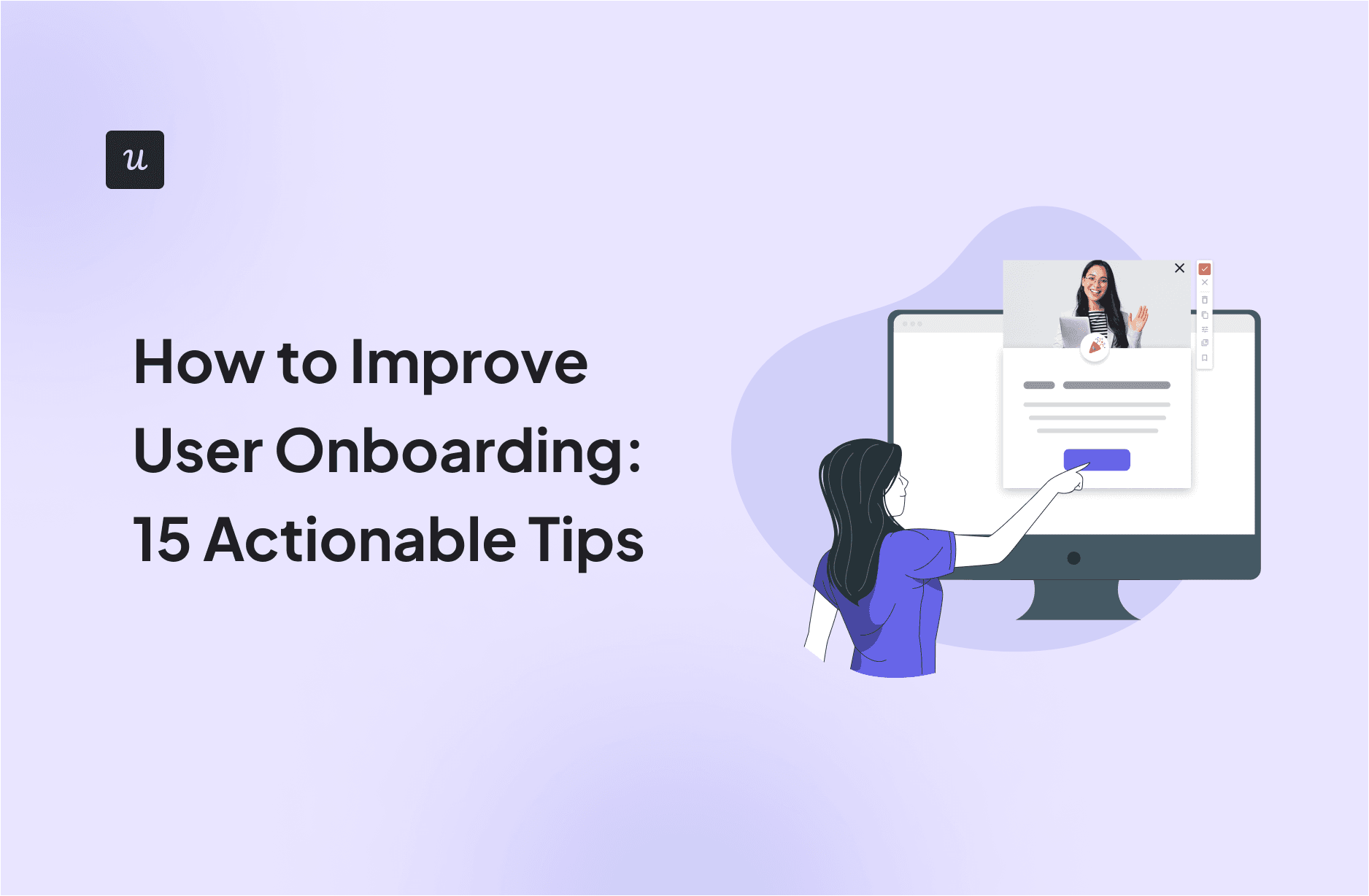
For SaaS businesses, learning how to improve user onboarding is a critical step toward driving customer loyalty and maintaining high retention rates.
What best practices have companies like Miro, Canva, and Zendesk used to create exceptional onboarding experiences?
Find out in this guide.
I’ll also walk through each step of optimizing your user onboarding flow — from simplifying the sign-up process to personalizing the user journey.
What’s your biggest challenge with user onboarding right now?
Understanding your main friction point is the first step in learning how to improve user onboarding.
How do you currently guide new users?
The right guidance can dramatically shorten the time to value.
How do you gather feedback to improve your onboarding?
Collecting feedback is crucial for data-driven improvements.
It’s time to fix your user onboarding flow.
Stop losing users to confusing and impersonal onboarding. Userpilot helps you create personalized, interactive experiences that boost activation and feature adoption. See exactly how to improve user onboarding with a live demo.
Try Userpilot Now
See Why 1,000+ Teams Choose Userpilot

Best practices to improve user onboarding process
Ready to improve your user onboarding flow and make the customer journey more engaging? Consider some best practices to get you started.
1. Keep the sign-up flow simple and short
The sign-up flow is the first critical step in user onboarding. To enhance the onboarding experience and reduce friction, keep it simple and short. Ask for only essential information.
Offering Single Sign-On (SSO) options, like Google or Slack, further streamlines this step by making it quicker for new users to sign up.
For example, Miro has expanded its SSO options to allow users to log in with platforms they already use, such as Slack or Apple.
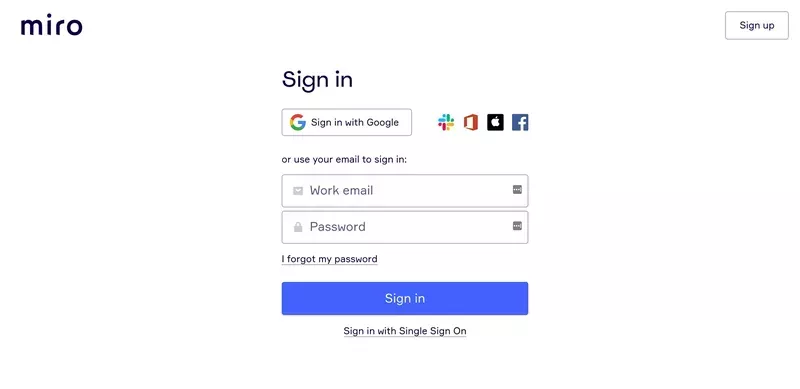
Another good example is Canva’s user onboarding experience. Canva overlays the sign-up modal on the homepage, for users to continue their task and explore the product seamlessly while signing up.
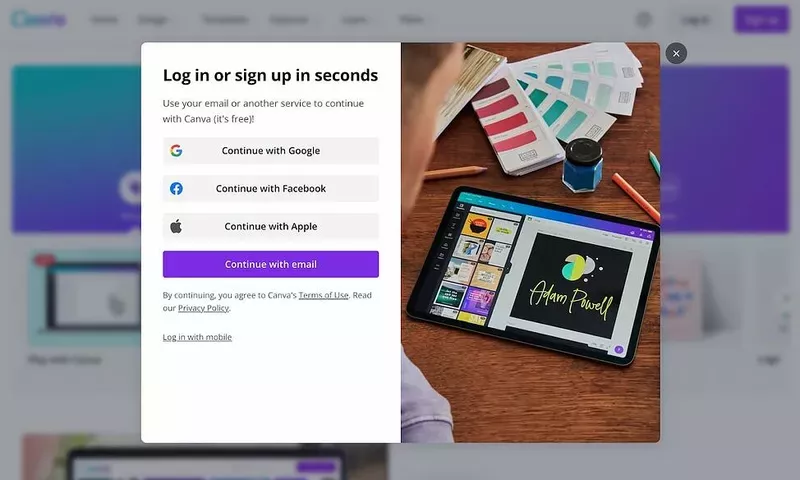
2. Make a good first impression with welcome flows
A well-executed flow will immediately engage users and guide them through essential features in the user onboarding and mobile onboarding process.
You can use a welcome screen to greet customers in-app and collect crucial data for future segmentation.
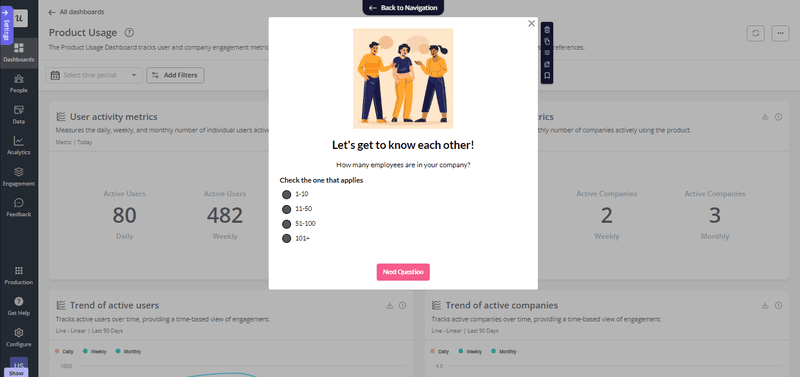
Afterward, follow up with a welcome email that includes helpful resources like tutorials and FAQs to confirm their registration and set clear expectations — similar to this welcome email from Miro:
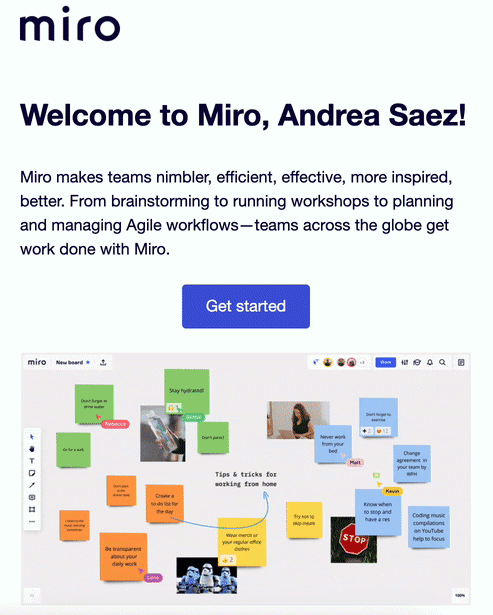
3. Personalize customer onboarding process for new customers
Personalizing the onboarding process guides new users to relevant features to help them quickly experience value.
For example, The Room used personalized onboarding flows to increase user activation by up to 75%, by guiding users through essential tasks.
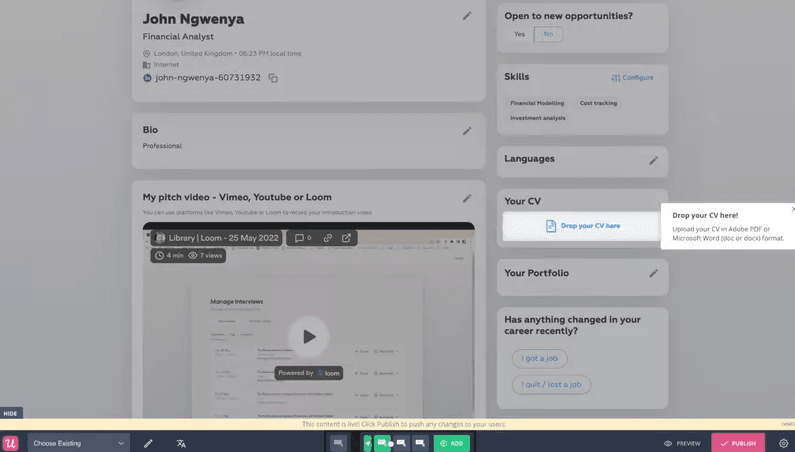
Here’s how to personalize your customer onboarding process with Userpilot:
- Segment users based on JTBDs you have uncovered in the welcome survey.
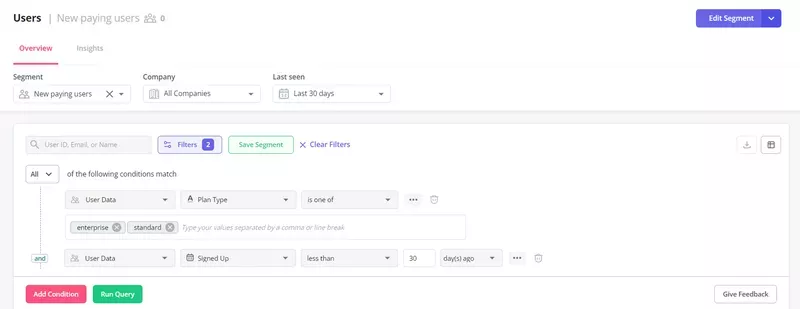
- Offer targeted tutorials or help articles based on user preferences or goals to ensure they quickly achieve product mastery.
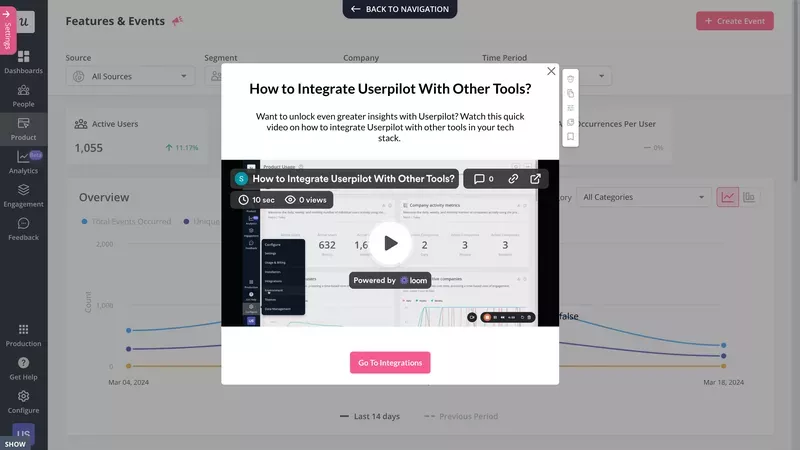
You can also personalize different onboarding elements such as the onboarding checklist. Here is an example of a personalization based on customer JTBDs:
Onboard and engage mobile app users by creating personalized messaging, push notifications, and surveys with Userpilot.
4. Duplicate the journeys of power users for new customers with the same goals
If a new customer shares similar goals, guiding them through the proven path of successful users increases their chances of long-term engagement.
First, perform a path analysis with Userpilot to track how power users interact with the platform.
Then, identify key points that lead to success and satisfaction.
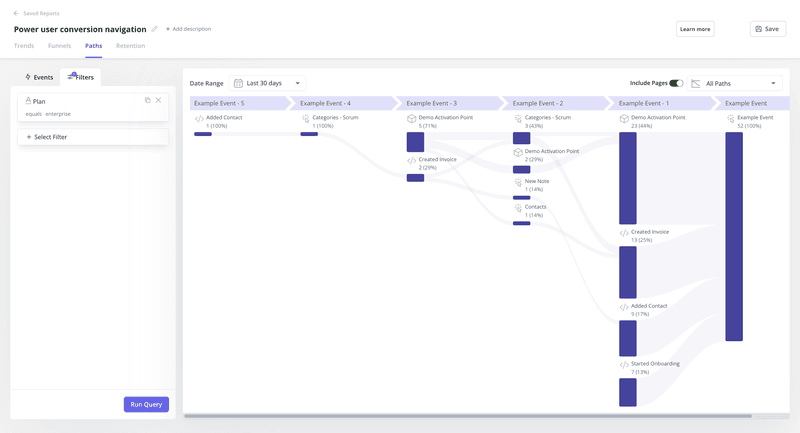
Next, duplicate these journeys for new users with:
- In-app messages: To nudge a new user towards critical features.
- Tooltips: To offer contextual guidance on how to use essential tools.
- Checklists: To create step-by-step task lists based on power user behavior.
5. Create an omnichannel customer experience
An omnichannel customer experience enhances customer retention by providing convenience and consistency throughout the user journey.
Some channels to consider include:
- Emails
- Websites
- Social media
For example, Zendesk excels at omnichannel customer support by offering multiple contact points — live chat, phone, email — while tracking all user interactions in one place.
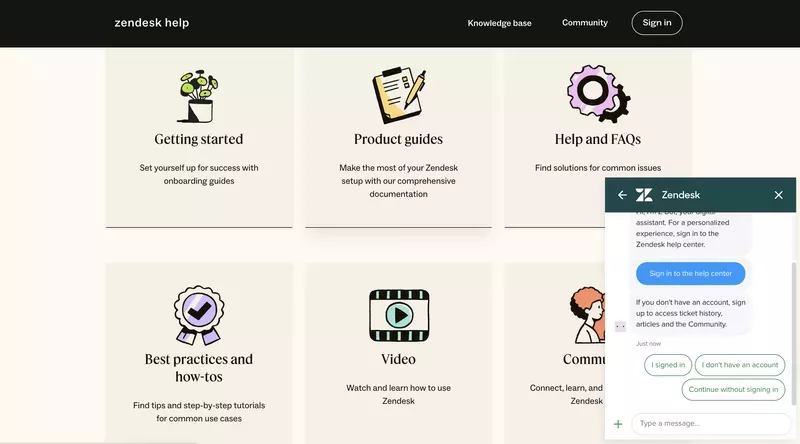
Spotify is another great example of delivering an omnichannel experience at the product level.
It has a web app, desktop app, and mobile app, all of which sync seamlessly.
For instance, if I’m listening to a song on my phone but also using my computer at the same time, I can skip to the next track from the desktop without interruptions.
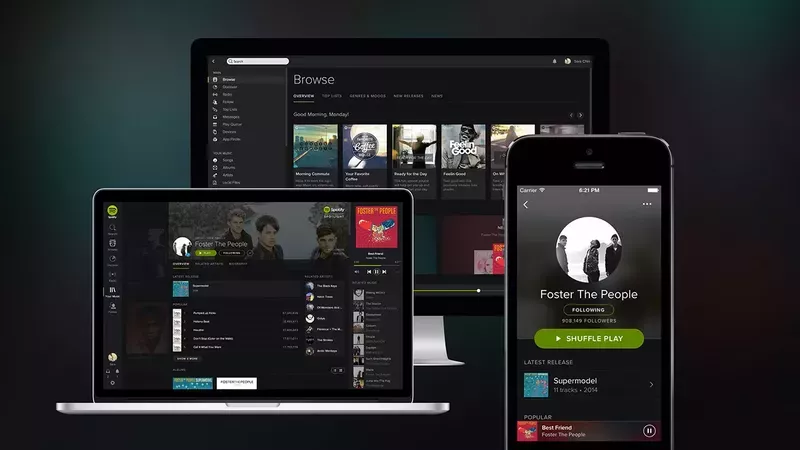
6. Gamify the customer journey with different elements to engage customers
Introducing gamified elements like points, badges, and challenges makes users feel rewarded and increases their motivation to explore the product.
For example, Groupize, a travel platform, gamified its user onboarding process with a virtual assistant named G.G. that guides users through personalized, interactive tours. This approach empowered users to learn at their own pace while staying engaged.
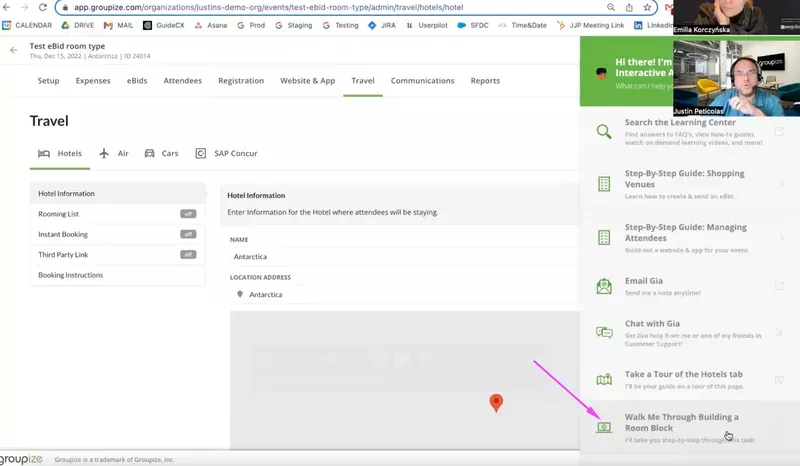
Similarly, Duolingo uses onboarding gamification to motivate users to stay committed to their learning goals with features like streaks and points.
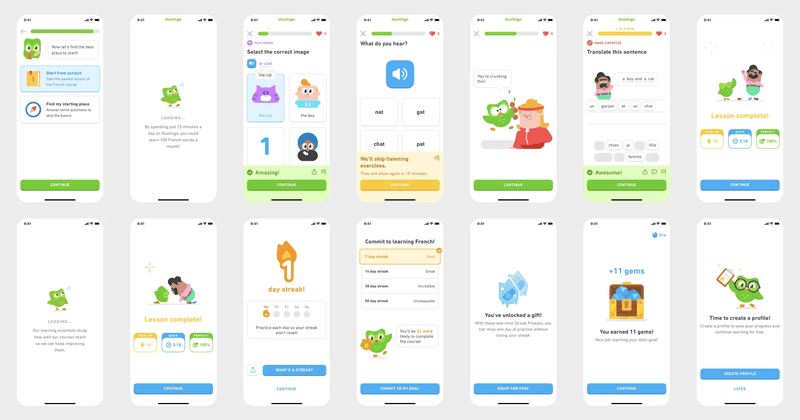
Fitbit also incorporates gamification by awarding badges to users as they achieve milestones. This recognition keeps users committed to their fitness goals.
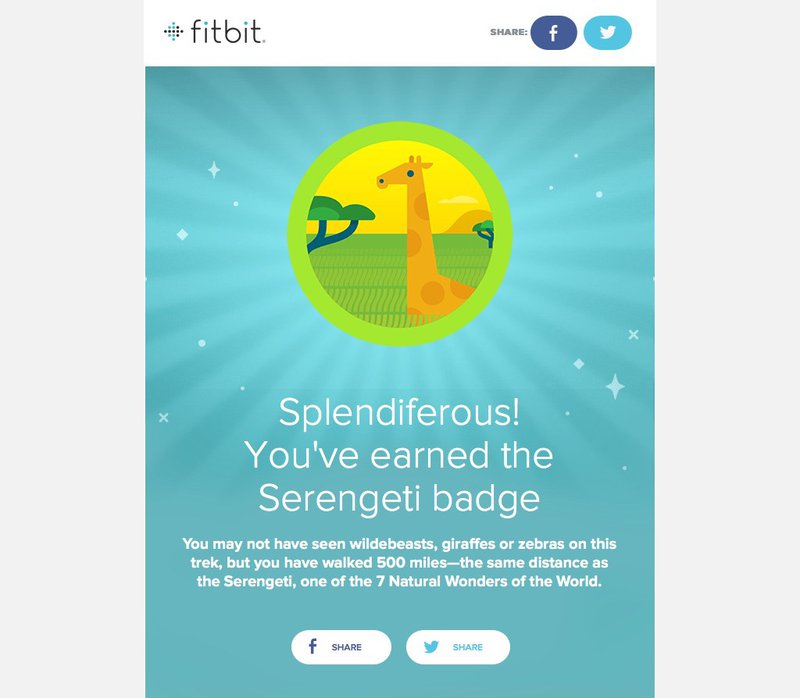
7. Streamline onboarding with checklists
Onboarding checklists help users complete key actions more quickly by breaking the onboarding process, leading to the “Aha moment” in actionable steps.
When planning your onboarding checklist, focus on 2 – 5 key tasks that lead to user activation so users can quickly get value from your product.
For example, Sked Social’s user onboarding checklist contains only four steps, and they found that users who completed it were three times more likely to convert into paying customers.
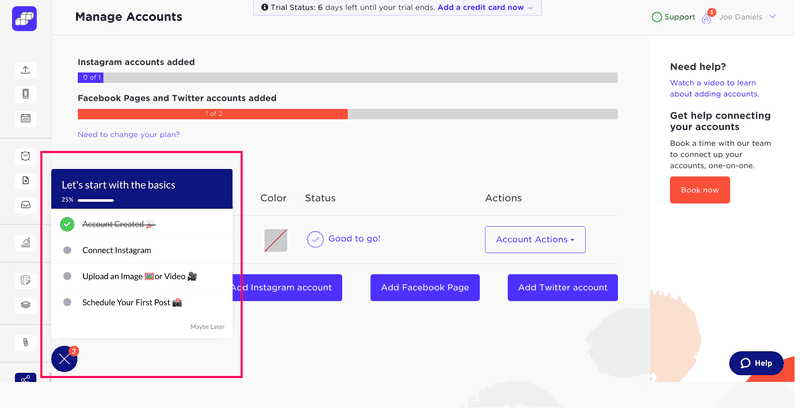
For a more effective onboarding process, further personalize checklists for different user segments to guide users toward their goals (example discussed above).
8. Replace boring product tours with interactive walkthroughs to shorten the time to activate
Traditional product tours often fail because they present information passively and lack personalization.
In contrast, interactive walkthroughs actively involve users and reduce time to activation.
For example, Attention Insight saw a 47% increase in activation rates after switching to an interactive walkthrough with Userpilot. This change also boosted engagement with key features, such as heatmap analyses, from 47% to 69%, and increased ‘Areas of Interest’ usage from 12% to 22%.
Here’s what Darius Jokubaitis, CMO of Attention Insight, had to say:

9. Implement self-service support for quick resolution
In-app self-service support empowers users to resolve issues independently without needing to contact customer support. One way to do this is by giving users access to a knowledge base for common questions.
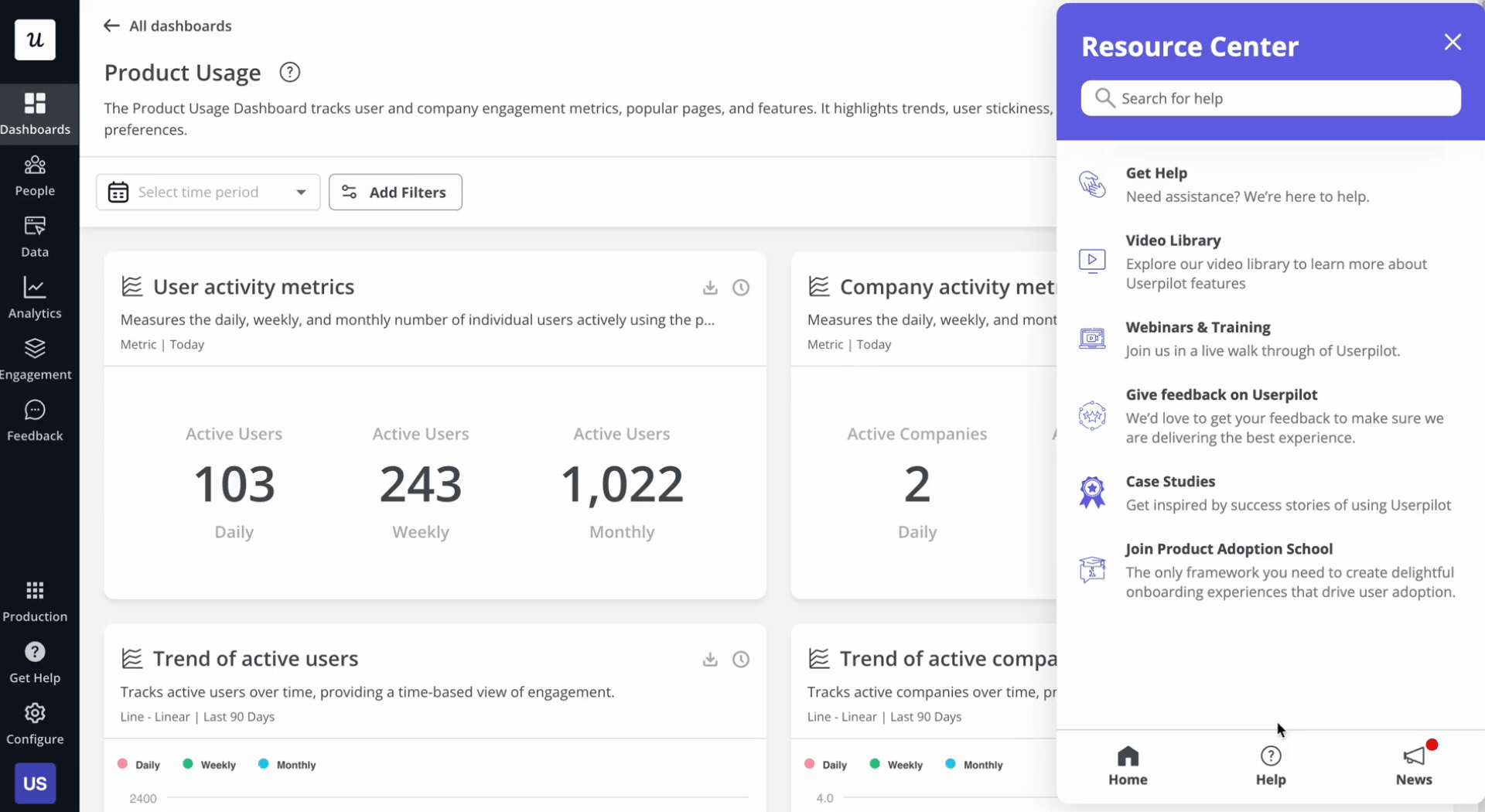
10. Drive customer success with continuous education
Continuous education ensures users remain engaged and well-informed about product features, updates, and best practices in the industry. Two effective tools for facilitating this are webinars and communities.
Webinars allow users to explore features and ask questions instantly.
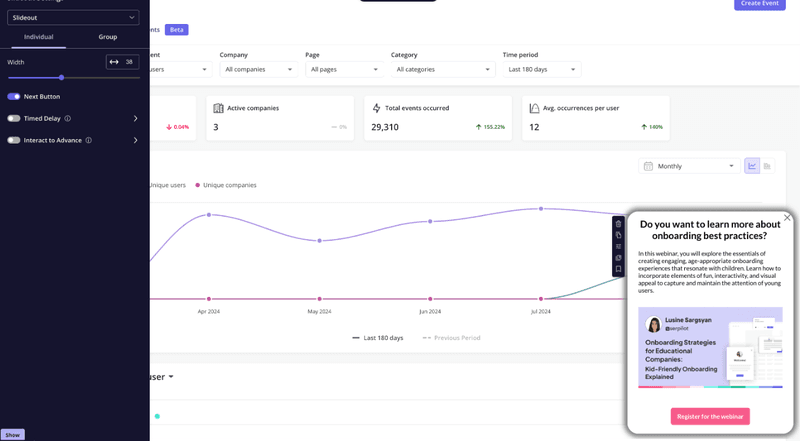
With user communities, you provide a platform for peer-to-peer learning and support. These spaces allow customers to ask questions, share best practices, and discuss experiences with others using the same product.
11. Collect and act on customer feedback to improve customer satisfaction
Collecting customer feedback is important to understand user experiences, spot areas for improvement, and ultimately drive genuine satisfaction.

In most cases, users are given three options to provide feedback: in-app surveys, mobile surveys, or email surveys. However, in-app surveys are highly effective for gathering feedback.
Here’s why:
- In-app feedback captures users’ attention while they’re actively using the product.
- Users provide feedback based on their immediate experience.
- In-app surveys are easier to follow up with.
Email surveys, while still useful for broad insights, tend to have lower response rates and delayed feedback, thus making it harder to address issues promptly.
12. Track user behavior with autocapture to identify any friction points
Autocapture automatically tracks user interactions such as clicks, text inputs, and form submissions in real time.
It gathers raw event data passively to give teams a comprehensive view of user behavior without requiring manual event tracking or an advanced setup.
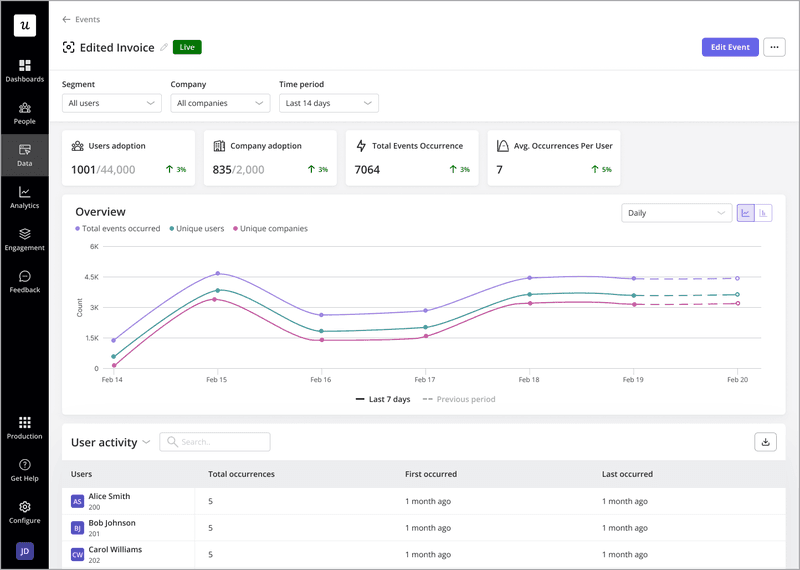
Get real-time insights with Autocapture.
Here’s how autocapture makes a significant difference:
- Pinpoints friction points: You can analyze interactions to see where users encounter challenges. For example, if many users abandon a form or drop it off after interacting with certain features, something may need to be optimized for clarity or usability.
- Streamlines user onboarding: Autocapture helps you to identify parts of the onboarding process where users struggle. Refining these areas would help users reach the “Aha moment” faster, and increase their likelihood of becoming active, long-term users.
- Helps in data-driven decision-making: Event data allows product teams to make informed decisions about where to focus development efforts to improve user experience.
13. A/B test your user onboarding flows
Use A/B testing to improve user onboarding by comparing different flows to see which performs better.
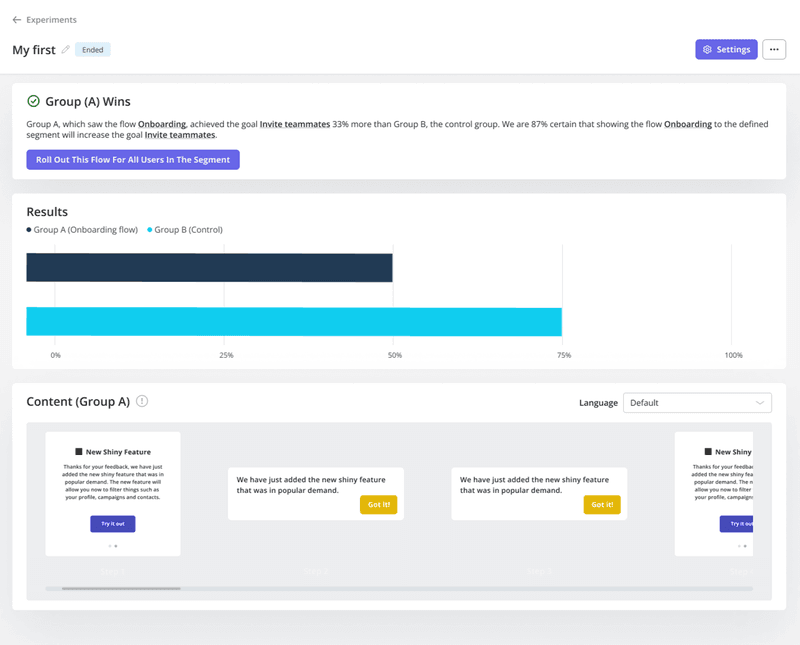
A/B test results in Userpilot.
To get users to the “Aha moment” faster, two A/B tests you can run are:
1. Controlled A/B Test: This compares a single onboarding flow (Flow A) against a control group with no onboarding flow.
For example, if your product is a project management tool, you could test the effectiveness of an onboarding flow in guiding users to create their first project. Show Flow A, to one group of users (Group A), while you show no flow to Group B (the control group).
2. Head-to-Head A/B Test: This compares two different onboarding flows (Flow A and Flow B) without a control group.
Using the same project management tool example, suppose you want to determine which onboarding method is more effective for new users: a video tutorial or a step-by-step guide. Show Flow A (the video tutorial) to one group of new users and Flow B (the step-by-step guide) to another.
14. Measure the success of your onboarding experience with analytics dashboards
Analytics dashboards offer real-time insights into user engagement.
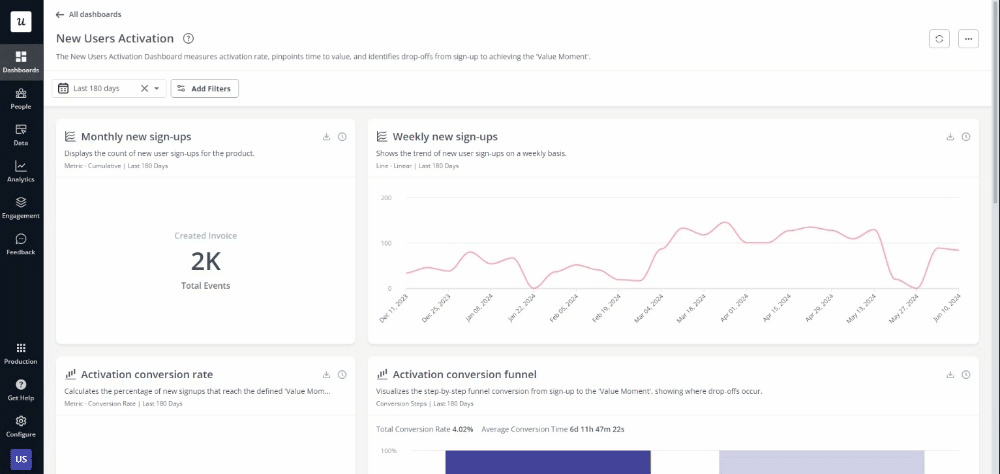
Tracking onboarding metrics helps you:
- Identify friction points.
- Optimize the user experience.
- Increase engagement and retention.
To measure the success of your onboarding experience, some key metrics we recommend you monitor include:
1. Completion rates: Measure how many users complete the onboarding flow. In our SaaS Product Success Metrics report, we analyzed checklist completion rates across seven sectors. Fintech and insurance companies had the highest completion rate at 24.5%, while MarTech companies had the lowest at 12.5%.

2. Time to value: Track how quickly users reach key milestones.
3. User engagement: Analyze feature usage and interactions.
15. Choose the right customer onboarding platform for your needs
It is vital to choose a tool that can assist you and help you in meeting your goals. Let’s consider some user onboarding tools that help you curate your ideal user onboarding experience.
Userpilot: Best value for money
Userpilot is recognized for providing excellent value, particularly for startups and small to medium-sized businesses.
Its key features include:
- In-app experiences: Easily create personalized onboarding flows to enhance user guidance. You will have access to a no-code builder to create different onboarding elements, a volatile resource center, and a well-designed onboarding checklist.
- Mobile onboarding: Create mobile-first onboarding flows, customizing welcome screens, carousels, and slideouts to deliver personalized messaging directly within your app.
- Segmentation: Target specific user groups with tailored messages based on behavior.
- Analytics: Gain insights into user interactions and feature adoption to optimize the onboarding process. Userpilot offers funnel and path analysis alongside retention analytics. With Userpilot’s analytics dashboards, you can easily monitor key product metrics. Moreover, Userpilot’s autocapture and session replay allows you to get a detailed overview of user behavior and use those insights during segmentation.
Userpilot’s affordability, combined with its robust feature set, makes it an ideal choice for those looking to maximize their budget while still delivering a high-quality onboarding experience.
Pendo: Best for detailed product analytics
Known for its low-code product adoption platform, Pendo is renowned for its simplified but powerful product analytics features.
With Pendo, you can:
- Design guides (including walkthroughs, tooltips, etc.) using a WYSIWYG studio. You can use Pendo’s free version to create user onboarding guides, but you’ll only get access to limited features and basic analytics.
- You can also build checklists with Pendo but not as standalone UI elements as users can only access them from the resource center (if they know they exist).
- Pendo product guidance for mobile works across Android and iOS mobile apps.
- Design polls and surveys to collect customer feedback in-app.
The tricky part when it comes to Pendo’s pricing is that you get to pay separately for different modules. Pendo’s yearly pricing can cost as high as $15K for the Pro plan and $50K for the Enterprise plan.
Also check:
Appcues: Best for mobile onboarding
If mobile-first onboarding is your priority, a tool like Appcues is a great fit. Appcues makes it easy to create intuitive, no-code onboarding flows for mobile users to get comfortable with essential features quickly.
Key features include:
- Mobile-specific tools: Design tailored onboarding experiences specifically for mobile users.
- Customizable templates that can be easily adapted to fit your brand.
- User engagement tracking: Monitor how users engage with onboarding flows and adjust strategies accordingly.
For companies prioritizing mobile-first strategies, Appcues offers the tools needed to ensure users quickly understand how to navigate their apps effectively.
Best all in-one tool for customer onboarding
Finally, if you’re looking for a complete, no-code solution for web-based onboarding, Userpilot offers the flexibility to design and test custom onboarding flows without a developer.
Conclusion
Onboarding your users doesn’t have to be a daunting task.
Conduct surveys to understand the user’s pain points, create custom flows for different users, and always pay attention to the data to improve your user onboarding.
You can get started onboarding users with Userpilot today. Book a demo to learn more!
How to improve user onboarding FAQs
Why is customer onboarding important?
Customer onboarding is important because it lays the groundwork for a successful customer relationship by teaching customers how to use the product effectively.
How can customer onboarding process be improved?
To improve the customer onboarding process, focus on:
- Customizing experiences to meet individual user needs.
- Simplifying instructions for better understanding.
- Providing proactive support throughout their journey.
- Incorporating interactive elements like checklists and walkthroughs.
- Regularly collecting customer feedback to strengthen your onboarding strategy.
How can I improve my onboarding process?
To improve your onboarding process, focus on these strategies:
- Personalization: Tailor the experience based on user segments.
- Clear communication: Use simple language and clear instructions.
- Interactive elements: Implement checklists and in-app guides.
- Feedback loops: Regularly collect user feedback to identify areas for improvement and drive customer success.
How can you speed up customer onboarding process?
To speed up your customer onboarding process, use a tool that provides in-app guidance, such as Userpilot, to help new and existing users quickly grasp key features without feeling overwhelmed.
What is a good client onboarding process?
A good client onboarding process includes:
- Welcome message: An engaging introduction to the product.
- Step-by-step guidance: Clear instructions on how to use essential features.
- Resource access: Providing tutorials and FAQs for self-service support.
- Regular check-ins: Following up with users to address any questions or concerns.

